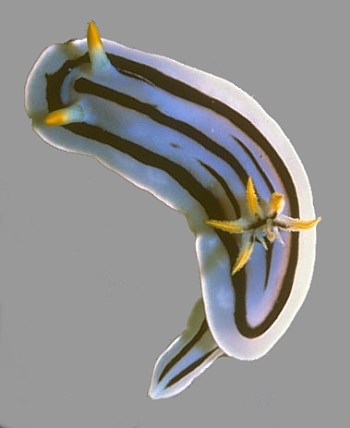
Chromodoris boucheti
Rudman, 1982
Order: NUDIBRANCHIA
Suborder: DORIDINA
Superfamily: EUDORIDOIDEA
Family: Chromodorididae
DISTRIBUTION
Western Indian Ocean.
PHOTO
Holotype. Mayotte, Comoro Is, Northern entrance to Longogoni Pass, 15m, March 1977. (18mm long preserved) PHOTO: P. Bouchet.
Very similar in colour to Chromodoris lochi and Chromodoris willani in having a bluish white body with longitudinal black lines, and pale gills and rhinophores. The three species can be distinguished externally as follows:
C. lochi: Gills and rhinophore clubs uniformly straw coloured or yellowish.
C. willani: Gills and rhinophore clubs translucent clear or bluish, with white specks
C. boucheti: Rhinophore clubs uniformly yellow. Gills - lower half white, upper half yellow, a black line runs from the base, up both the inside and outside edge of each gill, for a varying distance.
Originally described from the Comoro Islands and reported from the Maldives (Debelius, 1996). It is reported below from South Africa.
Reference:
• Rudman, W.B. (1982) The Chromodorididae (Opisthobranchia: Mollusca) of the Indo-West Pacific: Chromodoris quadricolor, C. lineolata and Hypselodoris nigrolineata
colour groups. Zoological Journal of the Linnean Society 76: 183-241.
Rudman, W.B., 1999 (November 18) Chromodoris boucheti Rudman, 1982. [In] Sea Slug Forum. Australian Museum, Sydney. Available from http://www.seaslugforum.net/find/chrobouc
Related messages
Re: Chromodoris boucheti with a yellow trim from Mayotte
April 1, 2009
From: Sandrine & Hugues Flodrops
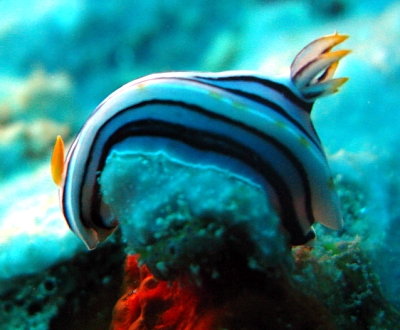
Concerning message #16373:
Dear Bill,
Here is an other one Chromodoris boucheti from Mayotte with a yellow trim around mantle ledge. It's similar to the specimen from Pemba [message #16373 ]. It's probably a colour variation.
Locality: Boulevard des platax "Passe en S", 16 mètres, Mayotte, Indian Ocean, 2 March 2009. Length: 35 mm. Photographer: Hugues Flodrops.
Thanks again.
Best regards.
Sandrine et Hugues
hugues.flodrops@wanadoo.fr
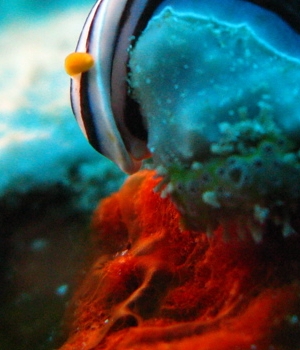

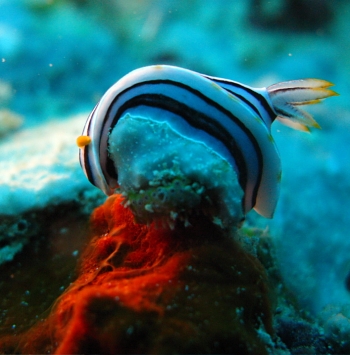
Dear Sandrine et Hugues,
This is an interesting find. It certainly seems this species can have orange and black marks around the mantle edge as can be clearly seen in the animal you mention from Pemba.
The presence of both a grey and a red sponge in your photos is also rather tantalising as either - or both - could be the food of this species. Chromodoris boucheti belongs to a group of similarly coloured species of Chromodoris some of which eat both a red species of Negombata and some dark grey thorectid sponges. The light grey sponge in your photo looks like a dysideid. Species of Chromodoris don't usually feed on sponges of that family but there are a few species with black lines which seem to prefer them. So it would not be unreasonable to find C. boucheti feeding on either of the sponges in your photo. If you have any other photos of it associated with either of these sponges or the dark grey thorectid in the Pemba message [#16373], I would be very interested. By coincidence, there is another photo from Pemba [#16384] showing C. boucheti associated with a light grey Dysidea probably identical to the one in your photos.
Best wishes,
Bill Rudman
Re: Chromodoris willani & C. boucheti
February 13, 2007
From: Bob Whorton


Concerning message #19417: -
Having looked at another shot from the scene, I think the orange-gilled individual is C. dianae as you first suspected. Pictures of C. lochi, C. willani & C. dianae enclosed.
Thanks for a very detailed analysis Bill, and I agree that these things could just be proximity arousals, which actually lead to nothing... "Ships in the fog" so to speak!
Locality: Halmahera, Indonesia, Halmahera Sea, July 2006, Sandy slope. Length: 3 cm +. Photographer: Bob Whorton.
Cheers,
Bob
drbob.whorton@btinternet.com
Whorton, R., 2007 (Feb 13) Re: Chromodoris willani & C. boucheti. [Message in] Sea Slug Forum. Australian Museum, Sydney. Available from http://www.seaslugforum.net/find/19444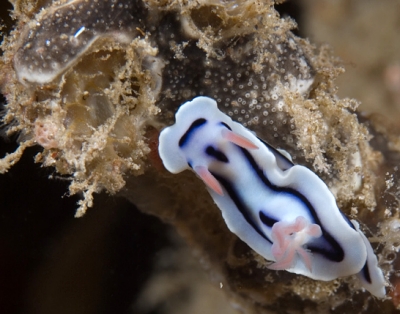
Dear Bob,
Thanks for the extra photos. Firstly, in your upper photo the left one is obviously C. willani but I am pretty sure the right one is not one of the colour forms of C. dianae. As I said in my earlier comments, the lack of a white speckled mantle [see insets comparing C. willani (left) and C. ? (right)] makes me pretty sure this is C. boucheti. Also in C. dianae the yellow colour on the gills is confined to the upper half [see Roberto Sozzani's photo (message #15230) showing both these features]. Another difference between C. dianae and C. boucheti is more difficult to quantify, but C. boucheti and C. lochi are more elongate in shape, with a narrower mantle skirt than either of the colour forms of C. dianae. I guess we will never be sure now, but on balance I am pretty sure it is C. boucheti.
The photo alongside is a form of C. lochi with pinkish gills and rhinophores. The greyish colony it is on, with whitish spots, seems to be an ascidian colony rather than a sponge. This ascidian seems to have partially overgrown a sponge colony, which is probably what the chromodorids are feeding on.
Best wishes,
Bill Rudman
Chromodoris willani & C. boucheti- mating?
February 12, 2007
From: Dr Bob Whorton

Unfortunately I mis-timed this mating event of Chromodoris willani and C. (forgotten) by minutes.
Several C. lochi (pink rhinpores & gills) were present in an area of 1 square foot too. 7 in all.
Locality: Hamahera, 14 m, Indonesia, Halmahera Sea, July 2006, coral slope. Length: 3 cm +. Photographer: Bob Whorton.
Bob Whorton
drbob.Whorton@btinternet.com


Dear Bob,
This is a useful message to get just after I posted Peter Southwood's photo of mating? Polycera capensis and P. chilluna [message #19387]. In my comments to that message I may have sounded a bit pedantic in saying that the animals were not actually mating although both had their mating apparatus fully extended. I explained that closely related species, seemed to participate in preliminary mating behaviour, when they were close to each other, but did not complete the mating once contact had been made. It seems their chemical signals are very similar, but once actual contact is made each species can recognise its own kind - even from close relatives. I suspect this photo is an example of that. The one with white-spotted gills is C. willani, as you thought, and the other one looks a bit like C. dianae, but I don't think it is. One form of C. dianae has the upper half of the gills bright yellow, but in that species there are very distinctive white spots [glands?] all over the mantle, like in the photo of C. willani. There is no sign of these spots in this animal. In many ways it looks like C. lochi, but the way the orange colour on the gills stops above the base does not occur in C. lochi.
An interesting possibility is that this is C. boucheti, which has a median black line down the inside of each gill, near the base. If you look at the lower left close-up, there are traces of black at the base of the orange on each gill. Chromodoris boucheti has normally been found only in the western Indian Ocean but we have a record on the Forum from the Maldives Islands [message #11895] and a possible record from Sulawesi [message #5982] so your animal may be the third from the eastern Indian Ocean.
The animals seem to be on a weedy rock, but if you look at the underlying background it is a dark gray sponge which I am pretty sure is Petrosaspongia sp which is the food chosen by C. dianae, C. willani, and C. lochi. We have a record of C. boucheti feeding on a sponge of the same family, so this could be a useful addition to our knowledge of its feeding specificity. If you have other photos of this C. boucheti, showing the gills from a different angle, I would be interested. I suspect the aggregation of similar animals like this is the result of them all preferring this food sponge. For completeness, perhaps you could send a photo of the C. lochi as well, and any photos showing more of the sponge.
Best wishes,
Bill Rudman
Re: Chromodoris boucheti with a yellow trim on Pemba
April 18, 2006
From: Pasquale Pascullo

Concerning message #16373:
Hello Bill,
I thought we IDed this as a C. boucheti from Pemba when I shot it in Feb 06. Now looking at this picture, with the yellow mantle trip, I am not sure. Let alone, I am not sure if the underlying surface helps you with a possible food?
Locality: Pemba islands, 10 meters, Tanzania, Indian ocean, Feb 06. Photographer: Pasquale Pascullo.
Pasquale Pascullo
pp@ppfotos.com
Pascullo, P., 2006 (Apr 18) Re: Chromodoris boucheti with a yellow trim on Pemba. [Message in] Sea Slug Forum. Australian Museum, Sydney. Available from http://www.seaslugforum.net/find/16384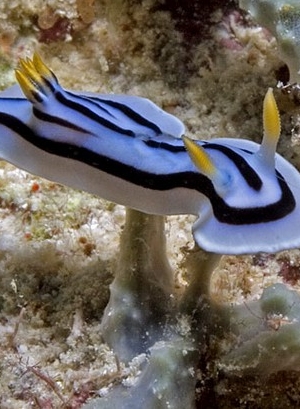
Dear Pasquale,
No this is C. boucheti. If the yellow edged one turns out to be different them it will need the new name not your one. However I think the black lines on the gills - both on the inside and outside edges - are a pretty good indicator of this species. We know little about this species so finding new things about its colour variation is always to be expected.
Concerning the sponge. It's always possible it is feeding on this sponge, but it looks in this photo to be crawling over the top of the colony rather than settling down to feed. I could be quite wrong so if you have any other photos of it or its kind on this sponge, or any other sponge for that matter, I would be interested in seeing them.
Best wishes,
Bill Rudman
Chromodoris boucheti with a yellow trim on Pemba
April 17, 2006
From: Rob Veelenturf

Hello Bill,
While diving from Pemba I saw this nudi. It looks to me like Chromodoris boucheti but with an unfamiliar yellow trim.
Locality: Pemba, 20 metres, Tanzania, Indian Ocean, 03 March 2006. Photographer: Rob Veelenturf.
Regards,
Rob Veelenturf
rob@cv-design.com
Veelenturf R., 2006 (Apr 17) Chromodoris boucheti with a yellow trim on Pemba. [Message in] Sea Slug Forum. Australian Museum, Sydney. Available from http://www.seaslugforum.net/find/16373
Dear Rob,
I haven't seen one with the yellow around the mantle ledge like this, but I am sure it is C. boucheti. The black lines on the gills seem to be a good character. I am very interested in the dark grey sponge in your photo which I suspect may be this species' food. Have you any more photos of this species from Pemba showing it on sponges? For that matter have you any photos showing the C. quadricolor and C. hamiltoni in your other message [#16372] being even slightly interested in any sponges?
Best wishes,
Bill Rudman
Chromodoris boucheti or C. lochi
November 21, 2005
From: Colin Ogden
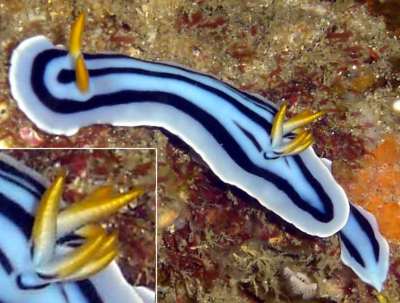

Hi Bill,
I have 2 photographs taken on separate dives on a deep reef at 42 meters. I first thought that the first photo was Chromodoris boucheti, and then I suspected it might be C. lochi because in some of the reference books I have it states that C. boucheti is found on reefs up to 35 meters and this was deeper than that. Also the black line on its gills is not as pronounced as in C. boucheti. Now on the same reef I at the same depth I have found another one which has much more black markings on its gills, so I am sure that photo 2 is C. boucheti. In this case is photo 1 also C. boucheti.
Locality: Gotham reef, Sodwana Bay, South Africa, Indian Oceoan coast. Depth: 42 meters. Length: 50 mm. Nov 2005. Coral reef. Photographer: Colin Ogden
Your help is appreciated.
Regards
Colin
scubaco@iafrica.com
Ogden C. M., 2005 (Nov 21) Chromodoris boucheti or C. lochi. [Message in] Sea Slug Forum. Australian Museum, Sydney. Available from http://www.seaslugforum.net/find/15316Dear Colin,
I guess the golden rule is that if you find something which doesn't fit the book, then the book may be wrong. We know so little about these animals that books are only as good as the information available when the book was written. One of the values of the Forum is that it is allows us to gradually build up new information as it becomes available. The depth range given for a species is really the 'known' depth range so increases to the range are always possible and always welcome. Certainly the small black line on the gills in the upper photo suggests it is C. boucheti, and I would agree that finding a more typical 'friend' at the same site is also very suggestive that it is that species. Chromodoris lochi never has opaque yellow pigment like this on its gills, although it can have a translucent yellow tinge at times. At present I am pretty sure there are no convincing records of C. lochi from the western Indian Ocean
Best wishes,
Bill Rudman
Chromodoris boucheti from the Maldives
January 15, 2004
From: Fredy Brauchli


Dear Bill,
There are not many records of Chromodoris boucheti from the Maldives. These two photos were taken at Veligandu, Rasdhoo Atoll, in July 1998.
The characteristic black line runs up from the base of each - half white, half yellow - gill.
Best wishes,
Fredy
brauchli@subaqua.ch
Brauchli, F., 2004 (Jan 15) Chromodoris boucheti from the Maldives. [Message in] Sea Slug Forum. Australian Museum, Sydney. Available from http://www.seaslugforum.net/find/11895Thanks Fredy,
A useful addition to our knowledge of the species. I suspect the greyish sponge it is crawling on may be its food but it is so overgrown with algae etc that I don't think it will be possible to identify it.
Best wishes,
Bill Rudman
Chromodoris boucheti from Mayotte
December 12, 2003
From: Marina Poddubetskaia
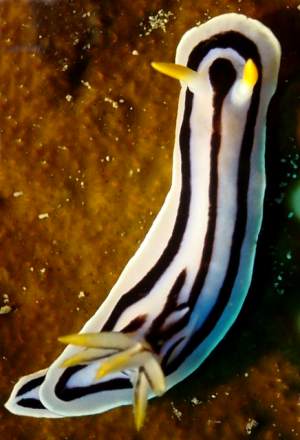
Dear Bill,
Here are some photos of Chromodoris boucheti from Mayotte (the Comoros).
It is my diving buddy who found them together et brought them to me. So, I'm sorry to tell you that they weren't found on this nice sponge and I didn't choose this sponge for its 'photogenic' aspect. I just placed these specimens near me and the sponge was right here :-)
Date: November 08, 2003
Location: Mayotte Island, France, Indian Ocean
Site: Passe en S, buoy n° 8
Depth: 16m
Size: Upper: 35mm, Lower: 30mm.
Cheers,
Marina.
nembro@nembro.info
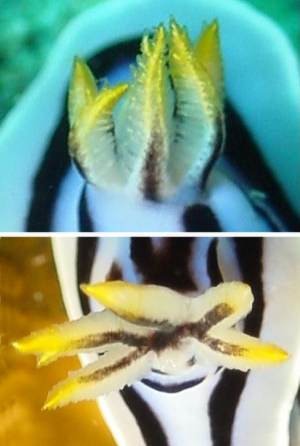

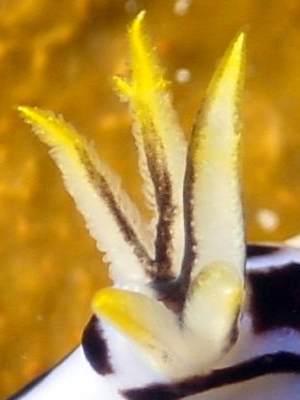
Thanks Marina,
It's good to get some more photos of this species. And thanks for the close-ups of the gills which show how it diifers from C. willani and C. lochi. Neither of those species have a black line up the inner and outer edge of each gill, and neither have a yellow tip.
Best wishes
Bill Rudman
Chromodoris boucheti from Pemba
November 19, 2002
From: Paul Young
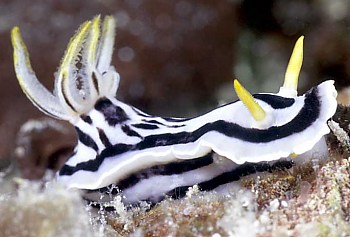
Dear Bill,
Here is another species that Charlotte and I found at Pemba Island, off the coast of Tanzania, western Indian Ocean, in November/December 2001.
Upper Right, Lower Left: 23 November, 2001, near Fundu Lagoon, West side of Pemba
Lower Right: 29 November, 2001, East side of Pemba
Best wishes,
Paul Young
young@underwater.org
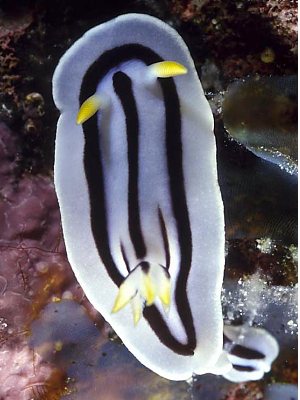
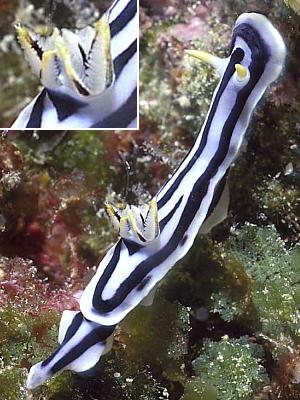
Dear Paul,
Thanks for these nice photos of Chromdoris boucheti which is another species found only in the Indian Ocean. The gills, with their yellow tips, and a black line up the bottom half of both the inner and outer edges, differentiates this species from other similarly coloured chromodorids with black lines on a bluish-white background.
best wishes,
Bill Rudman
Chromodorid with mutant gills from S.E. Sulawesi
April 30, 2002
From: Lindsay Warren
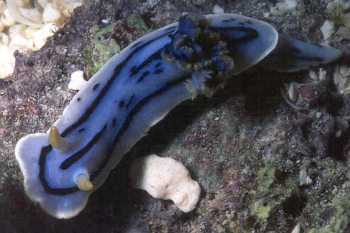
Dear Bill
Thought you might like to see this shot (unfortunately not as clear as I would like) of what I believe to be either a Chromodoris lochi or perhaps Chromodoris dianae with a rather odd looking branchial plume. It was found by Iain McKeith on 3 August 1999 at a depth of 2 m on Pulau Hoga, Tukang Besi Archipelago, S.E. Sulawesi (Operation Wallacea).
Size: 31 mm. Photo: Lindsay Warren.
Which id do you think fits it best?
All the best
Lindsay Warren
alldcl@compuserve.com
Warren, L., 2002 (Apr 30) Chromodorid with mutant gills from S.E. Sulawesi. [Message in] Sea Slug Forum. Australian Museum, Sydney. Available from http://www.seaslugforum.net/find/5982Dear Lindsay,
I think this is probably C. boucheti which has a yellowish rhinophore clubs and yellow-tipped gills, with a black line up the inside edge of the rachis. Its hard to be sure about the gill colouration in your photo but there are clearly signs of yellow and black. If it is C. boucheti, it is further east than its been reported before.
Best wishes,
Bill Rudman
Chromodoris boucheti from Tanzania
June 28, 2001
From: Bernard Picton

Hi Bill,
Here are some pictures of Chromodoris boucheti from Pemba Island, Tanzania, taken in February 1999. This was quite a common species in the area - indeed
it was interesting to see that the quadricolor type Chromodorids I was
familiar with from Indonesia (C. lochi, C. annae, C. magnifica, C. dianae, etc.) were replaced by C. boucheti and C. hamiltoni in Pemba Island.
The colouring of C. boucheti was very consistent - the black horseshoe line
around the gills which extends forwards as two tapering lines between the continuous black lines and the black lines on the lower parts of the gills were very diagnostic. One animal has an extra line of black spots around the mantle margin similar to Valda Fraser's animal; these are rather reminiscent
of the orange markings in larger C. dianae.
I enclose pictures which seem to show the animals feeding on a grey sand-encrusted sponge with hydroids growing out of it, in the second picture there is also a pale blue sponge, but I think this may be overgrowing the one which the Chromodoris is actually eating.
Bernard
bernard.picton.um@nics.gov.uk

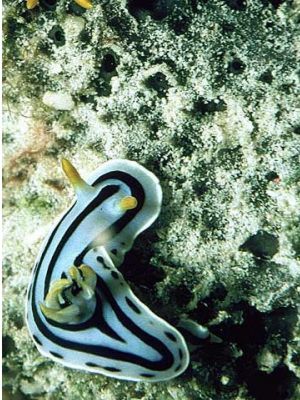
Thanks Bernard,
It's nice to get further information on what parts of these colour patterns are consistent and which parts are variable. It's also interesting to hear about the sand encrusted sponge food (upper right, lower right photos).
Hypselodoris bennetti feeds on a sand-encrusted sponge like this. For a long time we didn't know what it ate - it was never seen near a 'real' sponge, until someone realised the 'substrate' was in fact a sponge, covered in algae, hydroids etc, but still a sponge.
Best wishes,
Bill Rudman
Chromodoris boucheti from the Maldives
June 2, 2001
From: Jim Anderson
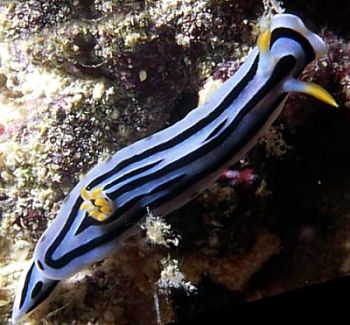
Dear Dr Rudman,
The attached photos of Chromodoris boucheti were taken in the Maldives.
The singleton [upper photo]in N. Male Atoll in 1999 and the group [lower photos] in Ari Atoll in 1996.
Regards,
Jim A
jander4454@aol.com
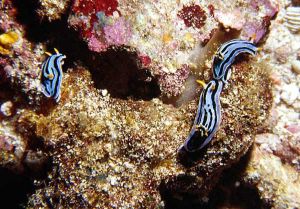

Dear Jim,
It's nice to get confirmation of its presence in the Maldives. This is quite tricky to sepaarate from Chromodoris lochi when you haven't got a good view of the black line on the inner edge of the gills.
Best wishes,
Bill Rudman
Chromodoris boucheti from South Africa
November 19, 1999
From: Valda Fraser
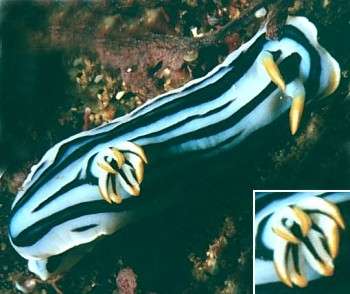
Dear Bill
I think this may be Chromodoris lochi, but it has too many stripes. I would appreciate your comments.
Locality: South Coast KwaZulu-Natal - SOUTH AFRICA. Scottburgh, on Rocky reef 24m, Nov 1999. Size: 57mm
Regards
Valda Fraser
iti04937@mweb.co.za
Fraser, V., 1999 (Nov 19) Chromodoris boucheti from South Africa. [Message in] Sea Slug Forum. Australian Museum, Sydney. Available from http://www.seaslugforum.net/find/1540Dear Valda,
Another interesting, if not unexpected find. This is Chromodoris boucheti which I described some years ago from the western Indian Ocean. It is very similar in colour to C. lochi and C. willani which I distinguish from each other at the top of the page.
it would be interesting with some of your common species to see if they are found regularly on a particular sponge and if so taking a photo of them on the sponge. Knowing the preferred food and the shape and nature of their egg ribbon are two bits of information that can be very useful clues to whether two very similarly coloured animals are the same species or two different species.
Best wishes,
Bill Rudman.
